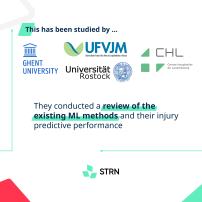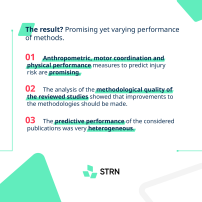Machine learning methods in sports injury prediction and prevention
30/03/2022
Share this post

Machine learning (ML) methods could be helpful in injury prediction and prevention, so which ML methods are currently used and are they accurate?
Let's look at the conclusions of a systematic review of ML methods.

Injuries are common in sport participation and can have significant physical, psychological and financial consequences. Various Machine Learning methods could be used to identify athletes at high injury risk and improve injury prevention.
These insights are based on the research of Ghent University, Universidade Federal dos Vales do Jequitinhonha e Mucuri (UFVJM), University Medicine Rostock, and Centre hospitalier de Luxembourg. Hans Van Eetvelde et al. published the paper "Machine learning methods in sport injury prediction and prevention: a systematic review" (Full text). Here are the key insights. 👇






For those who like a short text version of the authors' findings, here it is:
Did you know that current Machine Learning methods can be used to indentify athletes at high injury risk and be helpful in detecting the most important injury risk factors?
This has been studied by researchers at Ghent University, Universidade Federal dos Vales do Jequitinhonha e Mucuri (UFVJM), University Medicine Rostock, and Centre hospitalier de Luxembourg. They conducted a review of the existing ML methods and their injury predictive performance.
As a result they observed promising yet varying performances of the ML methods.
- Anthropometric, motor coordination and physical performance measures to predict injury risks are promising.
- The analysis of the methodological quality of the reviewed studies showed that improvements to the methodologies should be made.
- The predictive performance of the considered publications was very heterogenous.
They also found that...
- Tree-based models are currently the most popular ML models in sports medicine, because they are easy to visualize and interpret.
- Tuning the hyperparameters to optimize the performance of the ML methods seems to be underused.
- Understanding the relative weight of individual risk factors on the injury risk could be improved. This can result in targeted interventions.
So...
Researchers, businesses and sports organizations can collaborate to optimize current ML methods and improve the interpretation of the actual results.
Interested?
Reach out to STRN (as a practitioner, researcher, or R&D professional) and we will connect you with relevant partners.
Comments
There are no comments yet.




